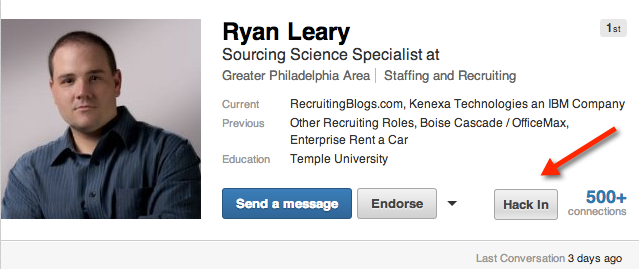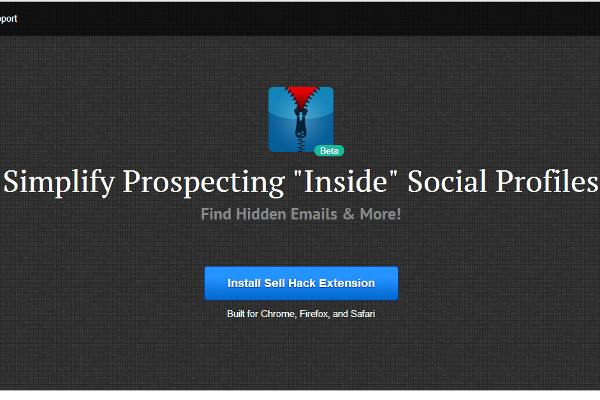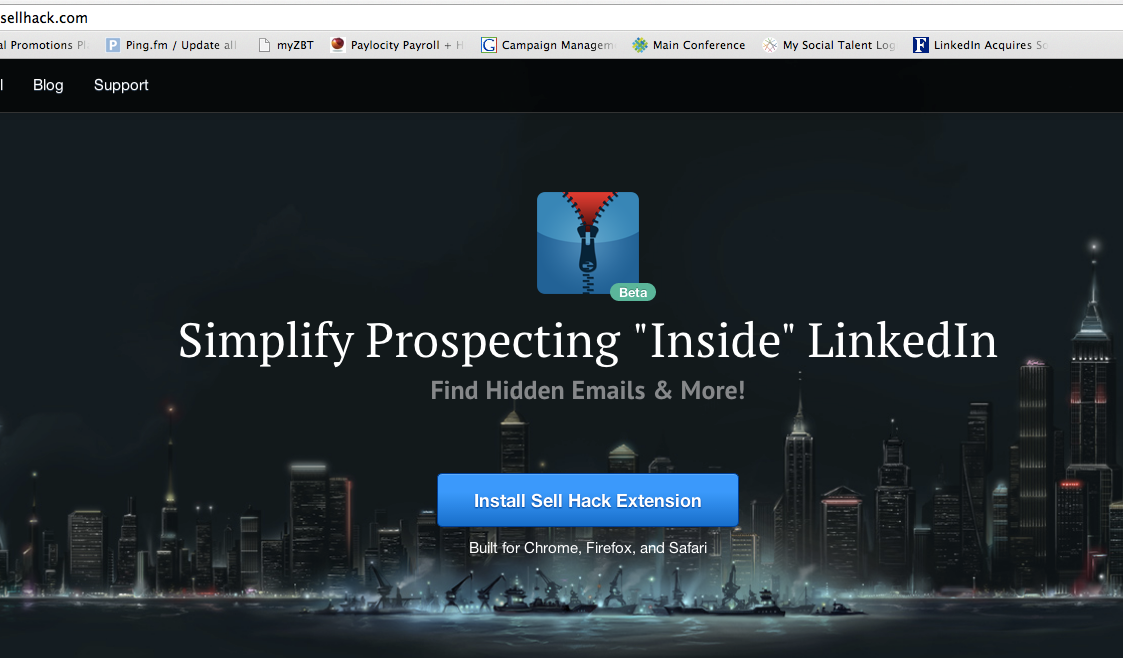 SellHack is one of those rare tools that actually delivers as promised, meets a real recruiting need and actually lives up to the hype – which isn’t easy to do, considering the amount of buzz and word of mouth that this emerging startup has built up in a relatively short amount of time. What makes SellHack really unique, however, is the fact that unlike so many other point solutions, it wasn’t developed as a saleable product, but instead, to solve a real challenge at a real company.
SellHack is one of those rare tools that actually delivers as promised, meets a real recruiting need and actually lives up to the hype – which isn’t easy to do, considering the amount of buzz and word of mouth that this emerging startup has built up in a relatively short amount of time. What makes SellHack really unique, however, is the fact that unlike so many other point solutions, it wasn’t developed as a saleable product, but instead, to solve a real challenge at a real company.
“We just kind of stumbled upon SellHack,” said founder Ryan O’Donnell. “I run a startup full time, and spend a lot of my day prospecting and selling on LinkedIn. It started as an internal tool, but we soon shared it with some of our friends and some recruiters, and once they started using it and we started getting their feedback, we realized that we were onto something.”
SellHack’s internal case use performed so well, in fact, that it quickly became a powerful enough tool to take to market, even if it’s not yet being actually marketed – or monetized. But if you’re in recruiting or sourcing, you’ll quickly discover that SellHack is one of the most invaluable tools today’s talent professional can have in their hiring arsenal.
O’Donnell, who also oversees video communication platform Sociagram, admits that Sellhack is “still in its infancy,” and he and his team are concentrating on “really trying to understand the shortcomings of LinkedIn and how our product could potentially address them.”
One of those shortcomings that led to the creation of SellHack, according to O’Donnell, was when prospecting on LinkedIn. When searching and filtering for a specific title, industry and target companies, he realized that while he had no trouble finding these targeted prospects, engaging them was another matter. “We’d try to figure out their e-mail address without being connected, which was really just maintaining a spreadsheet with all possible permutations of a corporate e-mail address and then manually testing those.”
At first, this involved opening a new message in GMail and using a workaround in Rapportive, a GMail plug in, to hover over each e-mail permutation to see if there was a valid profile attached. SellHack, however, automates this process, running all possible permutations against publically available e-mail sources to see which e-mail address is actually valid. Most importantly, SellHack integrates seamlessly with LinkedIn’s UI/UX, but is not reliant on their API.
LinkedIn & The End Of InMail
While LinkedIn recently sent SellHack a “cease and desist order,” the strongly worded language from LinkedIn seems to reflect that they have little recourse, instead encouraging users to disable it immediately and warning (ironically) about potential data violations, proving that LinkedIn is powerless when it comes to actually stopping usage of a tool that uses only public information and educated guessing without their proprietary developer code or API. Given the abhorrent data privacy violations LinkedIn commits as a core component of its business model, this strategy strongly indicates that they likely have no recourse to SellHack – and see it as a significant competitive threat.
That’s because SellHack uses the profile’s name, company and corporate URL or associated domain to “make some assumptions” about potential e-mail addresses to run against their data sources and validate which, if any, e-mail is associated with that profile. SellHack does not require any degree of connection with potential candidates to obtain their data, since it uses their public profiles instead of performing its permutation testing on the platform itself.
There are a few issues which, O’Donnell admits, still must be resolved to take SellHack to the next (monetizable) level, mainly the time it takes to generate and verify the accuracy of results, which is often still hit or miss when it comes to matching a profile to an active e-mail address. SellHack is still in R&D to fix these and other issues, and given the platform is new, O’Donnell wants to focus on improving end user experience and product efficacy before looking at turning this into a paid product.
In its current state, however new it might be, SellHack is more effective than at least one entrenched product making big bucks in the recruitment market: LinkedIn InMail. “SellHack is really no different than InMail, but by removing the LinkedIn platform entirely, you’re establishing 1:1 communication from inbox to inbox, not some mass marketing message or canned spam, which not only improves the open rate significantly, but also makes engaging prospects and candidates much easier than simply sending them an InMail,” O’Donnell said.
The company is currently exploring potential integrations and learning the HR technology landscape to figure out how to make a product that can both stand alone and integrate with any document or database that’s being used; they’re also working to add advanced search functionality and exploring features to offer “what end users really want,” with the goal of “building a complimentary technology around any recruiter’s workflow to make their process more efficient across all recruiting touch points,” O’Donnell said.
A significant part of this process involves soliciting and receiving feedback from recruiters and end users who have already adopted the product; SellHack reports listening actively to social channels like Twitter or unsolicited e-mails to measure recruiter sentiment and collect feedback that’s often built directly into the product. “I hold no punches saying that it’s still in beta, but hopefully we’re building a product that helps enable smarter and more effective recruiting and hiring.”
In other words, enjoy it now while the product is still free, and share your feedback directly with SellHack by e-mailing [email protected] or tweeting @SellHack, both of which are constantly monitored. “We’re new to recruiting, and we’re voracious to learn as much as possible so we can make our product better,” O’Donnell said. “We know what we don’t know, but we’re trying to quickly close the gap between a mature industry and our own expertise to build a more relevant solution for recruiting and sourcing.”
How SellHack Works
1. Visit SellHack.com and click the “Download Extension Button.” The download will immediately start with the version designed for the browser you’re using to access the website:
2. Once installation is complete, visit LinkedIn. You’ll see a new button on all profiles, allowing you to “Hack In.” Simply click the button:
 3. SellHack will automatically search for the e-mail addresses associated with this profile as well as linked social profiles like CrunchBase, Google, Twitter & Facebook.
3. SellHack will automatically search for the e-mail addresses associated with this profile as well as linked social profiles like CrunchBase, Google, Twitter & Facebook.
It’s easy, it’s free, and best of all, it works. See for yourself why SellHack’s only downside is that due to the unexpected demand and growth the product is already experiencing, it may be occasionally down due to maintenance to support its exponential growth and explosion in active users – all of whom have already discovered that while there are no silver bullets in sourcing, SellHack comes pretty close.
By Matt Charney
Matt serves as Chief Content Officer and Global Thought Leadership Head for Allegis Global Solutions and is a partner for RecruitingDaily the industry leading online publication for Recruiting and HR Tech. With a unique background that includes HR, blogging and social media, Matt Charney is a key influencer in recruiting and a self-described “kick-butt marketing and communications professional.”
Recruit Smarter
Weekly news and industry insights delivered straight to your inbox.







